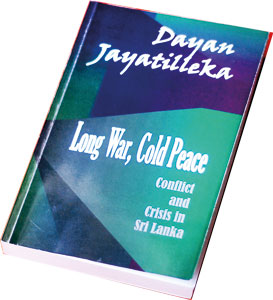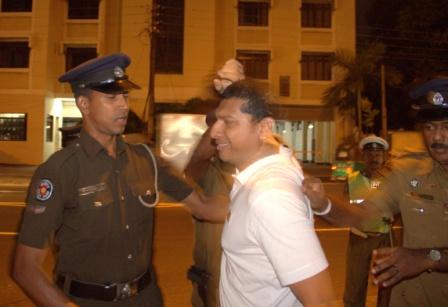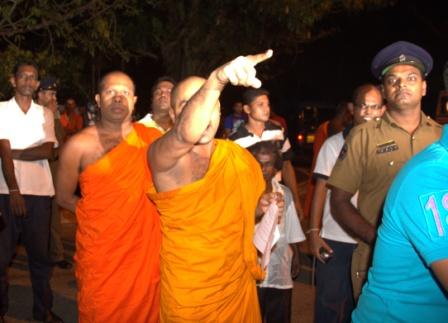by Shenali Waduge
Benjamin Dix is the chief protagonist in promoting presumed wrongs committed by the armed forces of Sri Lanka and emerges every time there an international event using documentaries and films meant to devalue Sri Lanka’s military achievement – we have become accustomed to these theatrics just as we are well aware that the lady in charge of human rights impatiently awaits an incident to take place to issue a deregulatory statement against Sri Lanka. Dix spoke in 2012 as guest speaker on “photographic journalism” at the Institute of Art and Ideas,http://iai.tv/video/the- killing-fields and based on this presentation some lies and truths are now highlighted.
“I went to Sri Lanka in 2004 as a photojournalist and managed to get up to the North of Sri Lanka which is the liberation of tamil tiger elam area in the North where I started working for the United Nations”
Benjamin Dix started as a Photographer for Berg Publishers (2002 – worked for 10months). He came to Sri Lanka from India in 2004 after the tsunami and went to Sri Lanka’s north. He joined Norwegian People’s Aid and worked as Project Manager from March 2005 to December 2006. NPA is an organization that is accused of links to Sudanese rebels. He joined the UN in January 2007 until December 2008. He is putting 22months of his knowledge to accuse Sri Lanka of war crimes.
“I was based there for 4 years as the liason officer between the Tamil tigers and the Sri Lankan Government”.
Can the Government and the UN please confirm this statement because he does not appear in any of the names associated with the negotiations held between LTTE and GOSL and moreover many questions surfaces with regard to this role.
“It’s a divided country. In the South you have the Buddhist Sinhalese who are also the Government of the country”
Perhaps Benjamin Dix is not aware that there are more Tamils living outside the North and amongst the Sinhalese.
Benjamin Dix should also look at Sri Lanka’s Government MPs and count the number of Tamil and Muslim MPs before making inaccurate statements.
“North and the East predominantly Tamil”
Benjamin Dix is also unaware that the 2 provinces are now demerged and the Tamils no longer are the majority in the East.
“It was the most impoverished district of the country”
The areas held by the LTTE were out of bounds for the GOSL and its military.
Inspite of LTTE making USD300m profits annually not a cent went towards uplifting the areas that they held within their control though that money was utilized to purchase arms and build sophisticated bunkers for the LTTE and homes for the LTTE families – this bit of information Benjamin Dix appears to leave out – which is confirmed by his statement. “Kilinochchi where the UN was based and where LTTE had its political and military headquarters and by far the most built up area”
“It was quite a vulnerable population” – at least he has said one thing right, because that was what LTTE tapped into and why the people feared to do anything against the LTTE for fear of their lives and that of their children. LTTE imposed taxes on all goods passing LTTE controlled areas, individual households were taxed and penalties were imposed on those who evaded payment. There was an LTTE ‘customs” located at Omanthai from which LTTE collected Rs.4-5m. Benjamin Dix was well aware of this – is his concern then for the Tamil people who were being illegally taxed? Tamil farmers had to pay taxes according to produce, even Tamil Government employees had to pay tax of 8% of their income. Then the fishermen that Benjamin Dix spoke of whose livelihoods were affected because of the conflict, well they had to pay Rs.5 per kill for transporting fish from Mannar to Colombo! Ltte had a more sophisticated network to collect money from Tamil businessmen based in Colombo and from the Diaspora.
“no electricity in the area”
How can a Government take care of its people when LTTE was running a defacto state disallowing Government or troops to enter these areas.
Moreover, the LTTE did not want the people to have electricity or television because it would have meant the LTTE’s atrocities would have been exposed. The LTTE chose to keep the people blind to their atrocities. Moreover the LTTE had blown up the power grids. These are now being restored and Kilinochchi and Mullaitivu areas that had 0% electricity in May 2009 now have 29% and 23% respectively.
“people had no links to the country”
Sri Lanka remains the only government that never stopped sending food, medical requirements and essential goods to the areas of the northern and eastern peninsula through the past 3 decades. If people had no links it was because the LTTE attempted to keep the people by force. The Tamil politicians have been fooling the people all through. The very MPs representing the TNA once claimed that LTTE was the sole representative of the Tamil people. The people with time will realize how the politicians have fooled the people just like the LTTE.
Today, the people of the North can freely travel throughout the country – there are no bombs. The former LTTE cadres are now employed and doing all that they were denied because the LTTE turned them into killers.
Ideally, the plight of these children whose formative years were held to ransom and women who could have done far more out of their lives than be turned into killers is what people like Benjamin Dix and Channel 4 should have made a documentary on – not the lies that are being relayed just to suit the sponsors.
“from the beginning of 2007 a new President came into power, Mahinda Rajapakse a Sinhalese nationalist in the South in Colombo and he came on this wave of crushing tamil tigers and crushing terrorism”
Firstly Mahinda Rajapakse did not come into power in 2007, it was on 17 Nov 2005.
Mahinda Rajapakse was elected President of Sri Lanka and not the South only.
Benjamin Dix may have been a good friend of a terrorist organization but a terrorist organization is one that kills innocent people and after 30 years suffering and over 5 peace offerings and negotiations all of which the LTTE turned down, the decision to military take on the LTTE was when it closed the sluice gates in Mavil Aru.
The LTTE closed the sluice gates in July 2006 and only after numerous appeals did the army receive orders to open the sluice gates in August 2006.
Closure of the sluice gates meant that 9510 Muslims, 8013 Sinhalese and 4439 Tamils living in 20 villages did not have water for livelihood and domestic use.
Before the military operation the LTTE dominated an area of 15,000sq.km in the north and eastern provinces of Sri Lanka.
LTTE was controlling 6792sq km & manning 11km long FDL from Kilaly to Nagarkovil via Muhamallai in the North & a 140km long FDL from Mannar to Kokkuthuduwai via Omanthai in the South.
It was in March 2007 that the land operations commenced in the Northern province
“on the border they started an almost badminton match….artillery going backwards and forwards”
Benjamin gives himself away in this statement because he confirms that the LTTE was firing artillery.
“army would put wayside bombs called claymore”
Another fictitious statement, the majority of claymore mines used was by the LTTE
The army cleared all landmines with the assistance of foreign land mine teams.
“they got international fame when they killed the Indian President in 1990”.
Benjamin Dix needs to update his general knowledge. Rajiv Gandhi at the time of his death was the FORMER Indian Prime Minister (not the President) and he was killed in 1991 May 21 to be precisse not 1990.
“the distinction between the Tamil tigers and the Tamil civilians were blurred and it was difficult for us as the UN and for the army to distinguish between who was a rebel and who was a civilian”
The LTTE when it suited them wore military attire and posed as civilians too
Many would recall how some LTTE mingled with civilians coming to Government controlled areas and blew themselves up killing not only military personnel attending Tamil civilians providing them food and medical aid but Tamil civilians too. (Vishwamadu – 9 Feb 2009)
“the mother became a sympathizer for the rebels by having a daughter for a rebel”
This statement is poignant and leaving aside the laws of international laws related to non-international armed conflicts and role of civilians, the people must think how a military should act when the rebels not only pose as civilians when it suits them and use their knowledge of military codes against the soldiers. Whose conduct is morally wrong?
“tiger girls in the bunkers doing their hair in the morning” – together with his description of Prabakaran showing his cadres Bollywood movies depicts that Benjamin Dix was privy to where LTTE had their bunkers, had close links with the LTTE female cadres which really goes to show where his allegiance was. LTTE was a terrorist organization. It is not the duty of humanitarian organizations to be taking sides but to take the side of the humanitarian disaster – in this light is it now the duty of these humanitarian workers to at least inform their head offices what the LTTE were doing in terms of how they recruited children and turned women to killers?
“training behind the battlefields in the jungles….training with the artillery…this is tigers putting landmines into the ground on the front lines….and the claymores where someone will hide in the bush and pull ” – didn’t Dix say earlier that the army was responsible for putting landmines!!!
His description of how the LTTE suicide boats operate is also noteworthy and shows how well he knew of the details.
“Kilinochchi the capital of the tigers. This is our UN office on the other side of the hedge… this was a civilian compound…but the tigers had moved the civilians out (unknown to us”UN”) and put one of their intelligence units in their office and that was bombed by the SL Govt”….”the tigers were using us (UN) as shields and under international law gives the Sri Lanka legitimate rights to bomb the area”
This is an absolute lie as crater investigation has revealed that it was the LTTE who was in Kilinochchi at the time that the UN was evacuating who had bombed not the UN compound but an area close to it.
Hypothetically if 10 to 15 air attacks per day as Dix mentions did not hit the UN office or injure any of its officers including Dix that shows that Sri Lanka’s air force was never involved in indiscriminate bombing
Dix also says that they knew that the LTTE would loot their generators and scaffolding, we know that 40 vehicles belonging to the Norwegian Peoples Aid “fell” into LTTE hands as well similarly LTTE would have been privy to much more.
“Casualties started to arise in early 2008….mass graves started to appear in the jungles”
Can Dix please tell us where these jungle mass graves are since he is so conversant in the jungle areas
Kilinochchi – came under GOSL control only 2nd January 2009 (by that time Dix was no longer in Sri Lanka). Kilinochchi was under LTTE control when the UN was told to move to safer locations (not evacuate). Thus when the film of supposed children begging UN officers to remain was taken, LTTE was very much present. It is left for the reader to imagine how such a film would have taken place under LTTE presence!
“On 17th August 2008 the tigers put out a letter to the population saying we now officially going out to war”
It was after the LTTE bombed close to the UN compound in Kilinochchi that the Government asked the UN and other international agencies to RELOCATE to safer areas and not EVACUATE
“Govt stopped us from importing materials we needed to make the bunkers …like concrete..like railway tracks” – how on earth can bunkers be built with materials like railway tracks!!
Benjamin Dix’s implication that the Tamil civilians were not provided food and that supplies to hospitals were affected is negated by these facts.
* January 2008-May 2009 58,393 metric tons of essential items were sent to Killinochchi and Mullaithivu districts in addition to 33,383 metric tons supplied to co-operative outlets during 2008 up to January 2009
* Every month, five to 600,000 litres of fuel was sent to each district despite fear that it may fall into LTTE hands.
* 900 government health staff in Mullaithivu and Killinochchi alone
* More than 20 litres of water per person per day was delivered and used.
* 175,000 personnel of the SLA have undergone local & international training to effectively be mentally & physically prepared to handle hostage rescue operations alongside a military operation against terrorism.
Yet LTTE attacked even the UN convoy carrying food and thereafter the military continued the supplies by sea. The numbers were purposely inflated so that the LTTE could stock the foods and essential items sent. Therefore, Sri Lanka becomes the only nation that continued to supply food, medicine and essential items despite knowing it may fall into LTTE hands but upholding its duty towards the citizens.
“one of the saddest pictures I took…became like many of the schools because of the children been taken by the tigers to fight”
If this is one of the saddest pictures why has Benjamin Dix not got Channel 4 to do a documentary of the LTTE’s forcible recruitment of children if as he says “education is everything to these people” and knowing that the LTTE was turning them into killers and denying them education or the joy of being with their parents and siblings?
Children grabbed from their homes, while studying and forcibly turned into killers all of which Dix and his colleagues would have seen as Dix himself is aware of the training camps in the jungles and that schools are empty as was told by his friend Pillai. Young females turned into suicide bombers or ordered to carryout suicide missions did Dix and others not care about the futures of these women? So please, enough of these double standards and emotional pep talks.
UNICEF has recorded 5956 abductions carried out by the LTTE for forced recruitment between January 2002 and December 2006, with 1012 of these being children under the age of 15 years
“education became impossible” – now that has changed not only are there over 900 schools now functioning there is a student population of 260,582 with 13.967 teachers. No one is kidnapping children to make into killers and suicide cadres now!
“my job was to work with the tigers and understand where they were going to do their fighting and where we could move 3-400,000 civilians”
– If the safety of the civilians was priority (not that of the LTTE) why did Benjamin Dix not secure their release from LTTE. The world cannot forget these civilians were being dragged from one end to the other not by the armed forces but the LTTE. Why did the LTTE not listen to these humanitarian agencies or did these agencies not insist on their release?
Yes the UN failed Sri Lanka’s 20m by siding with a terrorist movement and allowing Sri Lanka’s conflict to continue for 3 decades.
“this lady’s husband had been taken by the tigers to fight… if your fighting age is anything between 17 and 40 you are going to the front line to fight” – so do we classify these civilian fighters as “civilians” or “civilian combatants”.
“You’re our witness” – another poignant statement because Benjamin Dix alongside a host of other UN, INGO, NGO officers were working and living in Sri Lanka’s northern and eastern areas were witness to a host of crimes that the LTTE were committing all of which were not “humanitarian” and we demand to know what they did about these crimes because they should be standing trial for diminishing their role as humanitarian workers taking the side of a militant group over the Tamil civilians who were used and abused by the LTTE.
“people were barricading us in and begging us not to leave and through that 4 day period and tigers were moving their hard ware and artillery around….”
This clearly shows that the LTTE orchestrated these demonstrations because they were very much around the UN compound and amongst the UN officers
That there was no aerial bombing during the clipping of supposed demonstration outside the gates of the UN compound goes to show that on the 16th September 2008 the UN and LTTE were very much in Kilinochchi
“40,000” civililans were killed” – can Dix kindly prove this number…. It seems he is always talking in figures that somehow does not fit in with the actual total population of Tamils in Sri Lanka and that population is 2.4million of which 1million are overseas and if one spends a bit of time doing some calculations it is really impossible to believe the 400,000 or 500,000 figures that these former officers enjoy throwing into the air as if they personally counted them!
“when you remove the witness, when you don’t allow journalism the depths of war … but Sri Lanka was so much worse than Libya… its really bad”.
We are happy to do without “witnesses” who are one-sided and as for journalists we can say that numerous private tv stations including foreign were allowed to move with the troops to witness every stage of the conflict and none of them have said anything that remotely shows us that our soldiers were committing any crimes, Dix can summarize all his fictions in a book and sell like Weiss. The people of Sri Lanka will remain indebted to our forces no matter what
Dix is implying in the closing lines of his presentation that since the army did not know who was a civilian and who was LTTE, loosing thousands of civilians did not matter and that the army would not have to deal with them post-conflict – yet he forgets that 294,000 civilians were actually saved at the cost of 5000 military lives during the last stages of the war. If orders were clearly to fire at anything that moved as the US soldiers had been ordered to do in Vietnam then none in Sri Lanka’s military would have lost their lives nor would there be 11770 LTTE combatants. The GOSL has spent Rs.500million to rehabilitate and reintegrate to society – now save a handful they have either continued studied, engaged in a livelihood, taking to vocations like modeling and dressmaking, joined the security services, functioning as teachers and some are even playing for the national team in sports..…we are far more intelligent than to buy these lies.
A democratic Government has every right to protect the sovereignty of its country especially from terrorists and let’s not forget that having listened to the formulas provided by the West and its humanitarian agencies which could not stop the LTTE’s mission to kill civilians and only after 30 years of enduring terror that Sri Lanka’s military defeated the LTTE – that should be nothing Sri Lanka deserves to be punished for – especially when the very countries pushing for punishment have failed to deal with terrorism and their crimes against humanity goes unpunished or even investigated and the lady in charge of human rights cares not to waste a letterhead on them! We will not allow our soldiers to be humiliated with lies and fabrications because they remain the only military to have eliminated a terrorist movement while saving hundreds of thousands of civilians and thereafter designing an indigenous rehabilitation and reintegration program that no country can match. It may not be perfect but it still far superior to what other countries are unable to match because they are still battling terrorism.















